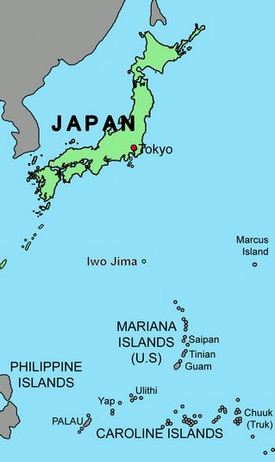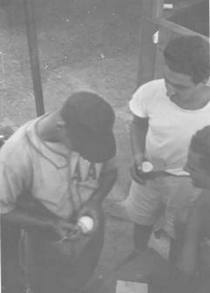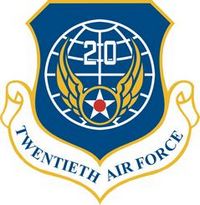

Playing Ball in the Marianas
(The 20th Air Force Pacific Tour of 1945)
by Gary Bedingfield
 In
September 1944, the Central Pacific Area Championship Series –
better known as the Service World Series - was held in
In
September 1944, the Central Pacific Area Championship Series –
better known as the Service World Series - was held in
Unfortunately, the Army
reacted with less haste and the Navy’s strength was obvious when the
Army crashed to a 5-0 defeat in the first game of the best-of-seven
series on September 22 at Furlong Field,
The Navy went on to win the
first six games of the extended series (it had previously been
agreed that all games would be played regardless of result in order
to provide maximum entertainment for the troops) while the Army’s
reinforcement of players languished on the high seas. “The Navy was
beating the hell out of the Army in
“When we got there, it was too late; all the Navy was gone.”
The Navy had succeeded in winning nine of eleven games against the Army and at the beginning of 1945 set off for a tour of forward areas of the Pacific to play exhibition games for the troops.
Upon their eventual arrival in
 |
|
58th Wingmen playing the 73rd Bombers on Saipan, August 1945. Joe Marty of the 58th Wingmen is at-bat. Charlie Silvera is the catcher and Joe Gordon is on deck (far left). |
“We were sent to Tinian and
 |
|
Enos Slaughter of the 58th Wingmen signs baseballs for fans. |
Tinian and Saipan are both in
the Mariana Islands and American forces invaded both islands in
mid-1944 and immediately began construction of what came to be the
world’s largest airfield for the Boeing B-29 Superfortress bombers
of the 20th Air Force. The B-29s had previously been stationed in
mainland
The 313th Flyers
team was based at North Field on Tinian, along with the 58th
Wingmen, who were at West Field, while the 73rd Bombers
were at Isley Field on
“We have been busy building our own tents to live in and our own park to play in,” Tex Hughson of the 73rd Bombers told Joe Cronin in a letter dated July 20, 1945. “The ball park is no beauty, but will answer the purpose. Of course, there is no grass and seats for ‘customers’ are made exclusively of bomb crates, of which we have plenty here.”
Herm Reich, a first baseman
with
 |
|
Joe Gordon of the 58th Wingmen discusses a close call with an umpire on Tinian. |
The three teams played a
round-robin series of games starting at
Buster Mills’ 73rd Bombers beat Birdie Tebbetts’ 58th Wingmen, 4-3, in that opening game with a ninth inning home run from Ferris Fain, and won the round robin series with a second win against Lew Riggs’ 313th Flyers.
“My club was on
During July and August, series
were played on Saipan, Tinian and Guam, with one series being played
on
In August 1945, Seabees cut a
baseball field in the side of a hill on
 |
|
“They’d just bring in the Army trucks and jeeps and so forth and park ‘em around the outfield grass.” |
On August 31, Nick Popovich
threw a 3-0 three-hitter for the 58th Wingmen over the 73rd
Bombers to clinch the
During the tour, a total of 27 games were played before an estimated 180,000 soldiers, sailors and marines. Although not all spectators were Allied as Charlie Silvera explains: “Japanese soldiers would watch the games from the jungle in the background and go back and hide when the game was over.”
 |
|
Relaxing after a game. Max West of the 313th Flyers is standing, far right. |
A question often asked regards
the amount of effort professional players put into these wartime
exhibition games. “We gave everything we had,” recalled Stan Rojek,
“[Joe] Gordon got in a fight with [Enos] Slaughter [58th Wingmen teammates],” adds Herm Reich. “Slaughter took out Stan Rojek [73rd Bombers shortstop], and Gordon told him to lighten up. Joe said, 'We're over here fighting for our country; not among ourselves.' Slaughter just played that way. He was an animal. You couldn't reason with him."
One day, on Saipan, Captain
Birdie Tebbetts thought he recognized the deep bleat of a fan who
used to get on him every time he played in
 |
|
Bananas were plentiful on Saipan for the 73rd Bombers. (Back row, left to right): Tex Hughson, Dario Lodigiani, Ferris Fain, Mike McCormick, unknown. (Front row, left to right): Charlie Silvera, unknown, Chet Kehn. |
Sure enough, it was the same
fan who always picked on Tebbetts when the Tigers played in
Furthermore, the travel was hard work. “God, we traveled all the time,” Max West, centerfielder with the 313th Flyers, explained to Todd Anton, author of No Greater Love. “We’d go and come into an island, we didn’t know where the hell we were, so we’d get in line and say we had flight fatigue and get a shot of whiskey. That’s my kind of medicine.”
Rugger Ardizoia clearly
remembers how important these games were to the troops. “One day we
were playing on
Despite all the island-hopping island hopping playing baseball it should be remembered that the players were still expected to perform their military duties as members of the Army Air Force. “The problem is,” Max West explained, “we had a job to do as flight/grounds crewmen and the other problem was they’d tell us about nine o’clock at night and say, ‘You’re leaving at six o’clock in the morning for wherever.’ We didn’t know if we were playing ball or getting reassigned to a new squadron.”
 |
|
Joe Gordon of the 58th Wingmen signs baseballs for fans. |
West worked on the ground crew
with the 313th Bombardment Wing. “I saw some horrific crashes … and
we on the ground crew would have to go in and, in all honesty, mop
up the human carnage. One time I went in to help, we pulled out this
pilot. I do not remember his name, but he had just flown all of us
to
After the conclusion of the 27 games, Stan Rojek of the 73rd Bombers was crowned the batting champion with a .363 average. Enos Slaughter of the 58th Wingmen finished second at .342 with teammate Joe Gordon finishing third at .328. Taft Wright of the 73rd Bombers was fourth (.319) and Lew Riggs, skipper of the 313th Flyers finished fifth (.314). Riggs led all hitters with 19 RBIs and Gordon took top honors with eight home runs.
Bill Schmidt of the 73rd Bombers was the top pitcher with a 4-1 won-loss record. Carl De Rose of the 313th Flyers was 2-0, while teammate Eddie Chandler struck out 28, but top strikeout artist for the tour was Tex Hughson of the 73rd Bombers with 41.
Following the conclusion of
the tour, most of the players were shipped back to the

|
58th Bombardment Wing (Wingmen) Based at West Field, |
||
|
Cpl Art Lilly |
IF |
|
|
Cpl Chuck Stevens |
1B |
|
|
Sgt Enos Slaughter |
RF |
Cardinals
|
|
Cpl Joe Gordon |
SS |
Yankees
|
|
Cptn Birdie Tebbetts |
C/MGR |
Tigers |
|
Sgt Joe Marty |
CF |
Phillies |
|
Lt Billy Hitchcock |
3B |
Tigers |
|
Pfc Howie Pollet |
P |
Cardinals |
|
Pfc Chubby Dean |
P |
Indians
|
|
George Gill |
P |
|
|
Pfc Ed Kowalski |
P |
Appleton ( |
|
Pete Layden |
OF |
|
|
Cpl Don Lang |
LF |
|
|
Pfc Tom Gabrielli |
C |
|
|
Cpl Roy Pitter |
P |
|
|
S/Sgt Vic Wertz |
OF |
|
|
Pfc Nick Popovich |
P |
|
|
|
|
|
|
73rd Bombardment Wing (Bombers) Based at Isley Field, |
||
|
Sgt Stan Rojek |
SS |
Dodgers
|
|
Pfc Bob Dillinger |
3B |
|
|
Taft Wright |
OF |
White Sox |
|
Mike McCormick |
OF |
Reds |
|
1st Lt Buster Mills |
OF/MGR |
Indians |
|
Cpl Charlie Silvera |
C |
Wellsville (PONY) |
|
S/Sgt Ferris Fain |
1B |
|
|
Sgt Dario Lodigiani |
IF |
White Sox |
|
|
P |
Red Sox |
|
Sgt Sid Hudson |
P |
Sanford (FSL) |
|
Pfc Chet Kehn |
P |
Dodgers |
|
Sgt Bill Schmidt |
P |
|
|
Cpl Al Lien |
P |
|
|
Cpl Johnny Mazur |
C |
Erwin (Appalachian) |
|
Bill Dudley |
Utility |
|
|
Ralph Lamson |
IF |
|
|
Cpl Herm Reich |
1B |
|
|
|
|
|
|
313th Bombardment Wing (Flyers) Based at North Field, |
||
|
Johnny Sturm |
1B |
Yankees |
|
Cpl Bob Adams |
2B |
|
|
Lew Riggs |
3B/MGR |
Dodgers
|
|
Cpl Nanny Fernandez |
SS |
Braves |
|
Cpl John “Swede” Jensen |
LF |
|
|
Cpl Max West |
CF |
Braves |
|
Sgt Walt Judnich |
RF |
Browns |
|
Cpl Bill Leonard |
C |
|
|
Burl Storie |
C |
|
|
Cpl Rugger Ardizoia |
P |
|
|
1st Lt Stan Goletz |
P |
White Sox |
|
Cpl Eddie |
P |
|
|
Cpl Carl DeRose |
P |
|
|
Cpl Al Olsen |
P |
|
|
Don Loeser |
|
|
Thanks to Bill Swank, Rugger Ardizoia, Charlie Silvera and Herm Reich for their help with this feature.
This page was added May 6, 2008.
 |